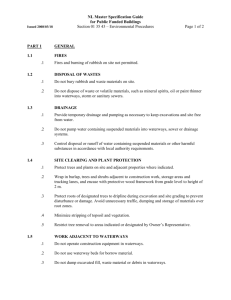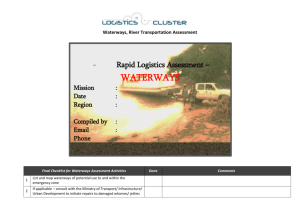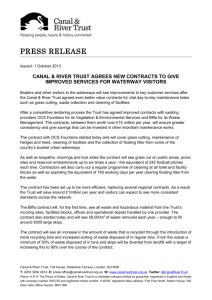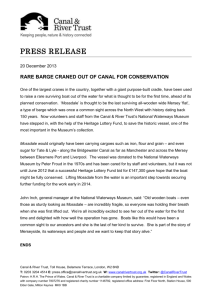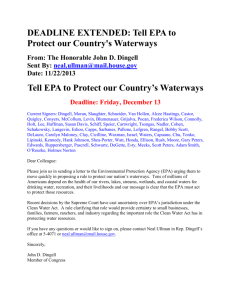- Waterways Forward
advertisement
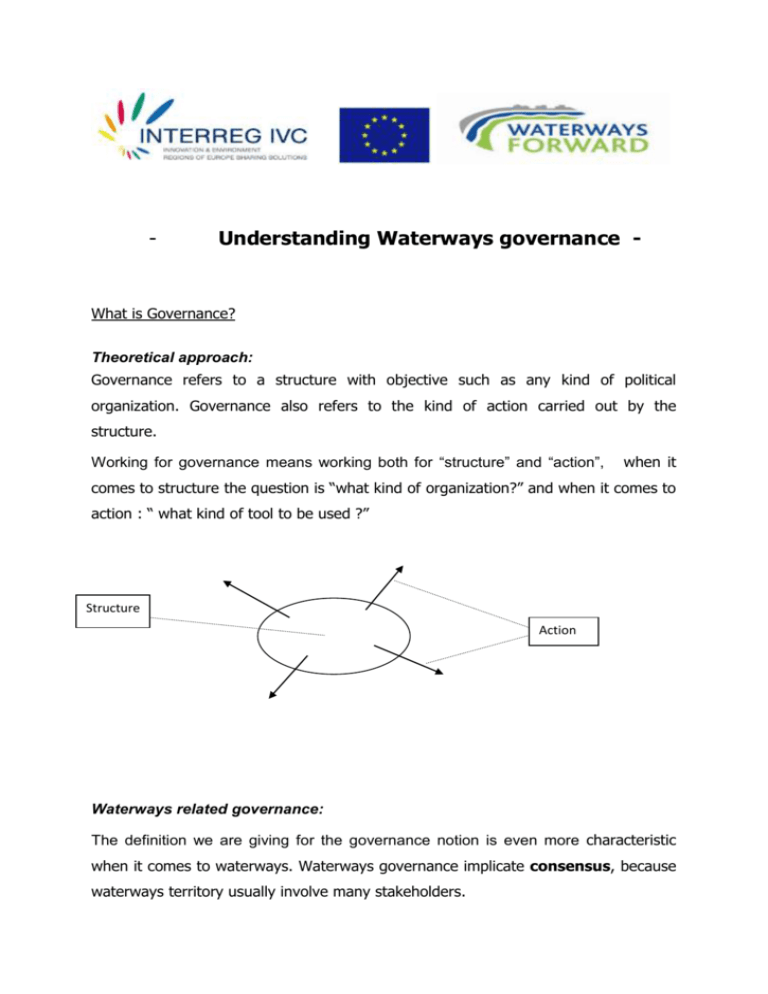
- Understanding Waterways governance - What is Governance? Theoretical approach: Governance refers to a structure with objective such as any kind of political organization. Governance also refers to the kind of action carried out by the structure. Working for governance means working both for “structure” and “action”, when it comes to structure the question is “what kind of organization?” and when it comes to action : “ what kind of tool to be used ?” Structure Action Waterways related governance: The definition we are giving for the governance notion is even more characteristic when it comes to waterways. Waterways governance implicate consensus, because waterways territory usually involve many stakeholders. To summaries, governance refers both to a structure and a range of action. Waterways governance is to govern with partnership and cooperation with local actors resorting to consensus. How to shape sub thematic? To introduce our sub thematic we have decided to produce a graph. The first box “structure/objective” refers to sub thematic which question the kind of organization. The other box “action/tool” refers to sub thematic questioning the kind of action toward waterways territory. Structure / target Action / tool Sub thematic identification: We had a chronological approach toward waterways development. Because partners are in different needs depending on the stage of development of their waterways. In this development process of waterways, we have identified four stages The first sub thematic referring to structure for governance is about “structure management and guidance”, we thought this was the first sub thematic to identified; as it is the firth pillar when planning a waterway development. Sub thematic identification Structure, management and guidance Developing multifunctional use of waterways Partnership and cooperation Heritage evaluation and promotion The second sub thematic is called partnership and cooperation, the following step after defining a management structure. In this thematic the main idea is to carry “consensus” as a key point for working. The third step is about developing a multifunctional use of waterways, our third sub thematic. And finally, we found that waterways heritage promotion and development was a major issue for many partners. Structure, management and guidance What is structure, management and guidance? Defining the structure, the management and the guidance process of waterways is the first step to implement a development process. More broadly, it means defining a common agreed strategy for territorial action. This thematic questions the kind of structure to organise the territorial governance. Therefore, it questions matters of leadership, of political momentum to carry the development project, and finally the kind of intuitional tool to be built to put in place governance. This thematic bring together questions linked with implementation of structural studies and diagnosis to introduce a common development strategy. The following graph reminds the three main issues to implement the waterway governance process. How to improve waterways governance? More concretely, partners interested in this thematic can be in need of tool for identification of key actors and distribution on a time scale in order to plan the project’s governance. What kind of tools, where are the best practices? Tools can be “Guideline for project” and “Time scale for mobilization of stakeholders”. Best practices have been developed by several WF partners, such as SRN, Telemarck, VNF; we are currently working on the identification of those best practices from the regional analyses. Partnership and cooperation: “making territory” What is partnership and cooperation? Partnership and cooperation is another important theme to base on for the development process of inland waterways. Cooperation enables partners grouping around common development strategy and partnerships are necessary to mobilize the parties involved. In both case, the notion of consensus management is essential in the process of exchange and cooperation. The main question beneath this thematic is: how to create a shared view of a territory and an identity, while using cooperation, exchange and partnership? The following graph reminds the three main issues to built up partnership and cooperation. How to create a territorial identity through partnership and cooperation ? In the Waterways Forward project, partners are in needs for tool to identify means for action in order to create a waterway territory from a single transport infrastructure. Indeed, cooperation and partnership is crucial in order to create an overall territorial coherence. What kind of tools, where are the best practices? There is several ways to work on the development of partnership and cooperation in order to make territory. Public-private partnership is an acknowledged tool but multi-governmental contract to finance the project is also another one. Best practices have been developed by several partners such as British Waterways and Voies Navigable de France. Cross-border cooperation is also a theme where best practices can be identified in Finland - Savonlinna, and Ireland-Waterways Ireland. Multifunctional use of waterways What is multifunctional use of waterways? Contrary to the two previous thematic, multifunctional uses of waterways refers to another step in the project: action. Integrated multifunctional use of waterways refers both to a spatial opening and a thematic opening. It is a spatial opening because waterways have to be considered as an opportunity to develop surrounded spaces, territories and not only rivers/water front. It is also a thematic opening because waterway promotion should give development prospects for different domain such as tourism, transport, planning, social inclusion… Within the scope of the waterways forward project, multifunctional use of waterways has been specified. Indeed, intervention for waterways territories are different whether they are integrated to a transport network or just isolated. There are two different models when it comes to developing waterways. . The first group refers to question such as how to maintain an efficient management of the waterways or how to develop user’s facilities. The other group refers to questions such as the increase capacities for both freight and tourism? And also, how to develop waterways while integrating a landscape analyses – perspective? How to develop multifunctional use of waterways? In order to develop multifunctional use of waterway, it is necessary to convince policy makers about the multiplicity of potential carried by waterways. In the Waterways Forward project, partners are in need for models showing off the potential of waterways, the territorial added- value, in order to stimulate the decision making process. What kind of tools, where are the best practices? Tools can be eco – valuation indicator and model to stimulate the decision making process. It can also be to draft framework for the management of consultation and cooperation. There are examples of best practices for multifunctional use of waterways in the Netherland - SRN, and also in Norway- Telemark. Heritage promotion What is heritage promotion? So as to develop multifunctional use of waterways, Heritage promotion refers to two kinds of waterways. Isolated waterways such as the Llangohen canal or the Canal du Midi, usually out of a transportation network and used nowadays mainly for tourism. Main issues for those waterways are the financing of modernization of this expensive heritage. Or it could also be about the management of tourism increased attractivity. Industrial revolution heritage waterways, integrated to a transportation network but no longer use, which is a heritage to be considered. Those waterways are no longer used for transport but they have been integrated in a transportation network. There is a potential for developing both tourism and transport. Questions for world heritage refer to issues such as the promotion of a specific patrimonial identity, the management of increased attracitvity? How to raise funds ? How to develop founding? Questions for industrial revolution heritage rather refer to the problematic of shrinking cities and region, how to make those places attractive again? What kind of territorial marketing and promotion? How to develop heritage promotion? Both world heritage and industrial heritage waterways are in need for development model taking into account a view including territorial marketing and promotion. What kind of tools, where are the best practices? Interesting tools would be planning model for the development of a territorial marketing process, to plan regeneration program around waterways, and to develop indicator to evaluate the needs for facilities binding with the increase of visitors. Best practices can be find in France-Vnf, UK- BW, Italy- Navigli Lombardi.

